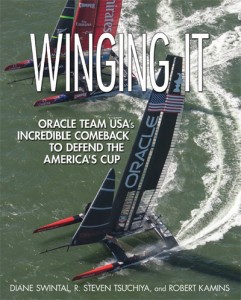
Cover: Winging It: ORACLE TEAM USA’s Incredible Comeback to Win the America’s Cup. Photo:©Gilles Martin-Raget
Winging It: ORACLE TEAM USA’s Incredible Comeback to Defend the America’s Cup
McGraw-Hill Professional/International Marine, 224 pages with 37 b/w photos, 12 charts and illustrations.
The book is now available at online sellers and in bookstores.
More information on availability
One of the Greatest Comebacks in Sports
Millions of sailing enthusiasts and casual fans alike watched the 2013 America’s Cup in awe as ORACLE TEAM USA, trailing one point to New Zealand’s eight and on the brink of losing the trophy to the Challenger, came back to win eight straight match-point races and successfully defend the most famous trophy in sailing.
The 2013 America’s Cup was raced in 72-foot wingsailed catamarans at speeds of 40-50 miles per hour in San Francisco Bay. Designed and engineered by each team, these multihulls were unprecedented, using hydrofoils to race in close quarters around an inshore course, watched by tens of thousands of spectators.
The teams of the Louis Vuitton Cup and the America’s Cup had to overcome technical challenges and discover new ways of sailing their boats, evolving their tactics and crew work on a nearly daily basis. Onshore, organizers worked to re-shape sailing’s most historic competition for the cutting edge of technology, and broke new ground in presenting sailing to a mass audience.
Winging It tells the story of racing for the 2013 America’s Cup, including coverage of the epic match between Emirates Team New Zealand and ORACLE TEAM USA which came down to a last winner-take-all race, plus the Louis Vuitton Cup Final between Emirates Team New Zealand and Luna Rossa Challenge, along with an overview of the Semi-Finals with Sweden’s Artemis Racing.
Sailors and armchair sailors who are America’s Cup fans will follow the development of the new aspects of yachting’s most historic event. Over the three-year work-up to the 2013 match, the authors interviewed skippers, sailors, designers, race officials, and event organizers to explain how and why they chose a multihull class for the event, how the teams learned to cope with the radical new boats, and how the sailors adapted to racing the AC72’s.
Charts and diagrams show the race courses used for the regattas, components of the AC72 yacht, and historical comparisons since the beginning of the Cup in 1851. The book also explores the long history of the America’s Cup as a crucible for conceiving and developing innovative technology, along with the financial forces and nationality issues which have been shaping the Cup for over 160 years.